The Enchanting Saga of Atmospheric Lights: Unraveling the Global Tapestry of Myths and Facts
Atmospheric lights, those ethereal natural phenomena that light up the skies, have captivated human imagination for centuries. From the aurora Borealis dance in the northern hemisphere to the rare, enigmatic glow of light pillars, these luminous displays have been a source of wonder, inspiration, and sometimes fear across various cultures.
Key Takeaways
- Atmospheric lights have been interpreted differently by cultures around the world, often attributed to divine or supernatural forces.
- The aurora borealis, or Northern Lights, hold a special place in Norse mythology and Sámi folklore.
- In Australian Aboriginal mythology, atmospheric lights are integral to their storytelling and spirituality.
The Aurora Borealis: A Divine Light Show in Norse Mythology
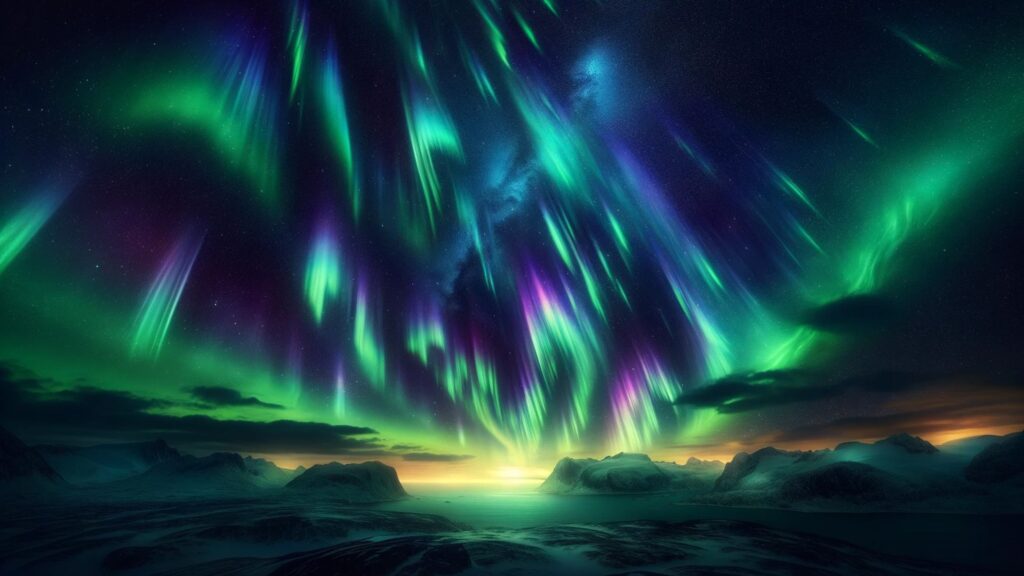
The Norse viewed the aurora borealis as a bridge to the gods. This majestic light show was believed to be the Bifröst Bridge, a glowing arch leading to Asgard, the realm of the gods. The Vikings interpreted these lights as reflections from the shields and armor of the Valkyries, warrior maidens who carried fallen warriors to Valhalla.
The Bifröst Bridge: A Path to Asgard
The Norse people saw the vibrant aurora borealis as the Bifröst, a burning rainbow bridge that connected Midgard, the world of humanity, to Asgard, the realm of the gods. This interpretation highlights the auroras as not just a natural phenomenon but a divine passage, embodying a connection between the earthly and the ethereal.
Valkyries’ Ethereal Path: Warriors’ Escort to Valhalla
In Norse legend, the shimmering aurora was often attributed to the Valkyries, the formidable female warriors who escorted fallen heroes to Valhalla. The lights were imagined as reflections from their glittering armor, creating an awe-inspiring spectacle in the sky, symbolizing honor and valor.
Thor’s Thunderous Battles in the Skies
Another Norse interpretation ties the aurora borealis to Thor, the god of thunder. The lights were sometimes perceived as the sparks and flashes from Thor’s hammer, Mjölnir, casting a brilliant display across the heavens during epic battles. This association with Thor underscores the Norse culture’s reverence for strength and heroism.
Freyja’s Feather Cloak: A Symbol of Hope and Beauty
Freyja, the Norse goddess of love, fertility, and war, was also connected to the auroras. It was believed that the soft, flowing lights were the reflections of her feathered cloak, gently swaying in the celestial winds. This perspective adds a layer of grace and beauty to the mythology surrounding the aurora borealis.
Sámi Legends: Spirits Dancing in the Sky
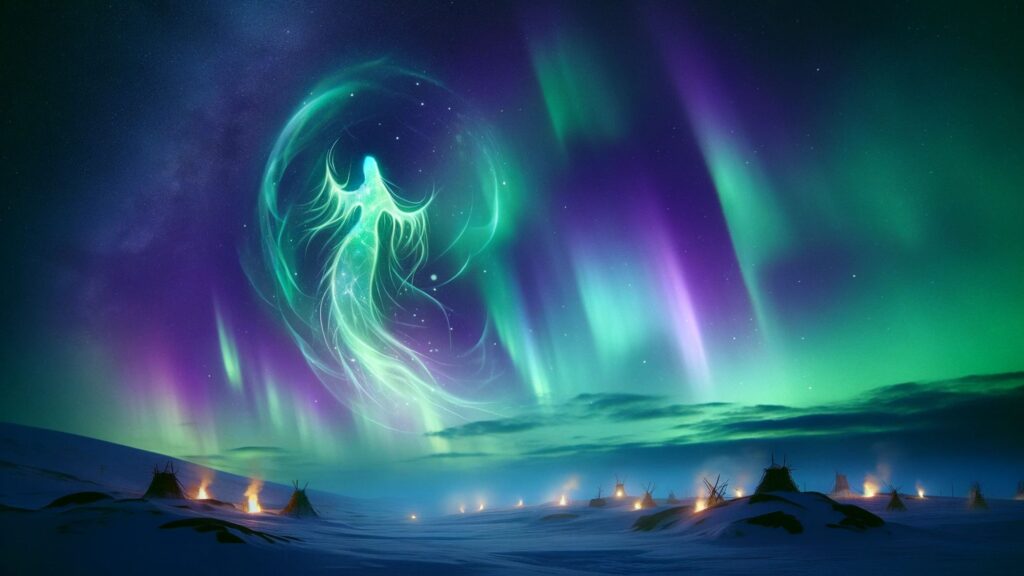
In Sámi folklore, native to the northern regions of Norway, Sweden, Finland, and Russia, the Northern Lights were seen as the energies of the departed. The Sámi believed that these lights were the souls of the dead, engaging in a celestial dance.
The Ancestral Spirits of the Aurora
The Sámi people, indigenous to the Arctic Circle’s regions, hold a profound spiritual connection with the natural world. They perceived the aurora borealis as the manifestation of their ancestors’ spirits. These lights dancing across the sky were not just a celestial phenomenon but a sacred display of their lineage and heritage.
The Siida System: Community and the Northern Lights
In Sámi culture, the concept of ‘Siida’ – a community of people and families living together in harmony with nature – is central. The aurora borealis, in this context, is seen as a symbol of the unity and interconnectedness of the community, with the lights representing the collective spirit and resilience of the Siida.
Joik Songs: Celebrating the Aurora
The traditional Sámi ‘joik’ – a unique form of cultural expression akin to song – often features the aurora borealis. These joiks are not just melodies; they are stories and tributes, encapsulating the awe and reverence the Sámi feel towards the auroras, symbolizing both the past and the present.
Sámi Shamanism and the Northern Lights
Shamanism plays a significant role in Sámi spiritual life, and the aurora borealis is deeply entwined in these beliefs. The shamans, or ‘noaidi,’ often interpret the lights as messages from the spirit world, guiding their communities. This belief underscores the profound connection the Sámi have with the aurora, viewing it as a bridge between the physical and spiritual realms.
Aboriginal Tales of the Southern Lights

The indigenous people of Australia have their own interpretations of the auroras. In their lore, the Southern Lights are a manifestation of their ancestors’ fires, a symbolic representation connecting the living to the spiritual world.
Dreamtime Stories: The Aurora Australis in Aboriginal Lore
For the indigenous people of Australia, the aurora australis, or Southern Lights, is woven into the fabric of their Dreamtime stories. These tales passed down through generations, often depict the auroras as a cosmic dance of spirits and ancestors, playing a crucial role in the Aboriginal understanding of the universe and their place within it.
The Ancestral Fires: A Symbol of Enduring Connection
In Aboriginal mythology, the Southern Lights are often seen as the campfires of ancestors in the spirit world. This imagery reflects a deep spiritual bond between the living and their ancestors, with the auroras serving as a luminous reminder of this unbreakable connection across time and space.
Tiddalik the Frog and the Southern Lights
One popular Aboriginal tale involves Tiddalik the frog, who once drank all the water in the world. It is said that during this time of great thirst, the Southern Lights appeared more vibrant, interpreted as the ancestors’ way of guiding the people towards water, symbolizing hope and resilience in times of crisis.
Cultural Rituals and the Aurora Australis
For many Aboriginal communities, the appearance of the Southern Lights is an occasion for cultural rituals and ceremonies. These ceremonies are not just social gatherings but are deeply spiritual events where the community comes together to honor their ancestors and the natural world, with the aurora australis playing a central role.
Gazing into the Heavens: The Luminous Lore of Greece and Rome
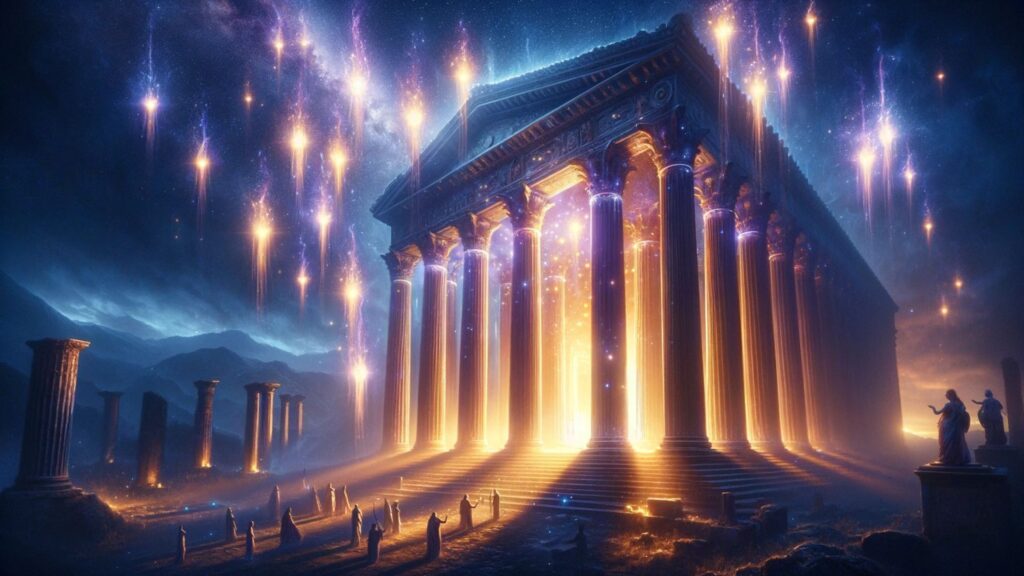
The ancient Greeks and Romans, with their rich pantheon of gods, viewed atmospheric lights as celestial communications. To the Greeks, the Northern Lights were associated with the goddess of dawn, Eos, painting the sky with her rosy fingers. The Romans, on the other hand, saw them as a display of Aurora, the goddess of dawn, signaling the arrival of a new day.
Greek Mythology: Eos and the Rosy Fingers of Dawn
In ancient Greek mythology, the aurora borealis was often associated with Eos, the goddess of dawn. She was believed to have opened the gates of heaven for the Sun to rise, and the auroras were seen as her rosy fingers stretching across the sky. This personification of the Northern Lights as a divine harbinger of a new day was a testament to the Greeks’ reverence for natural beauty and celestial phenomena.
Roman Interpretations: Aurora and the Gates of Morning
Similarly, in Roman mythology, the aurora borealis was linked to Aurora, the goddess of dawn. Romans believed that Aurora flew across the sky, announcing the arrival of the Sun, and the luminous auroras were seen as the glowing path of her chariot. This myth reflects the Roman culture’s appreciation of the interplay between light and darkness and the cyclical nature of day and night.
The Homeric Hymns: Celestial Poetry and the Northern Lights
The auroras found their way into the Homeric Hymns, ancient Greek poems praising various gods. These texts often described the celestial display of the Northern Lights in poetic terms, highlighting the Greeks’ artistic and emotional connection to these natural wonders.
Philosophical Interpretations: Natural Phenomena in the Ancient World
Greek and Roman philosophers also pondered the auroras, often discussing them in their treatises. While their interpretations were more grounded in early scientific thinking, they still marveled at the spectacle, seeing it as a natural phenomenon that stimulated both intellectual curiosity and spiritual wonder.
Chinese Dragon Fights and Celestial Battles
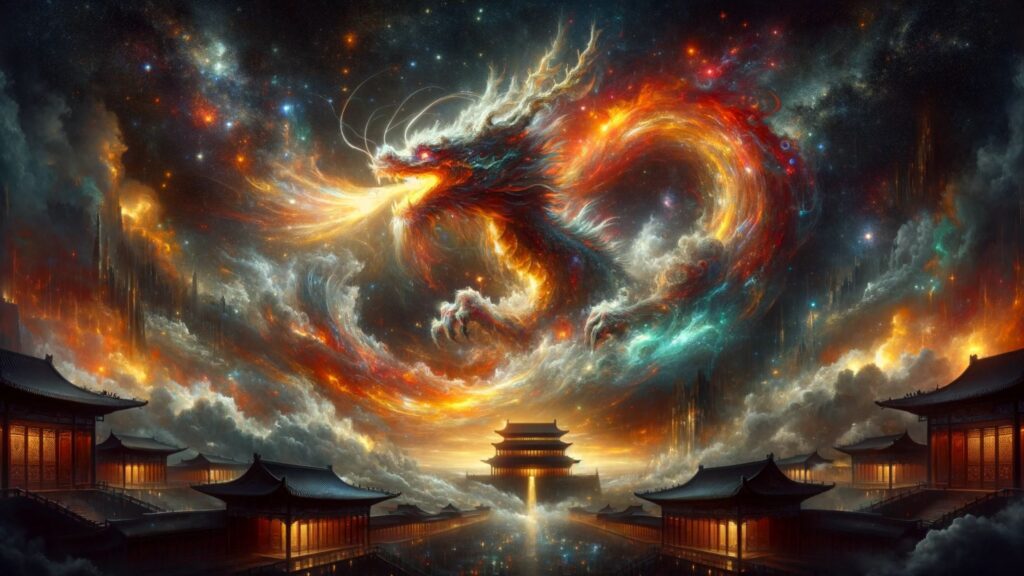
In ancient China, the Northern Lights were often perceived as dragons fighting in the sky. These celestial dragons, breathing fire across the heavens, were seen as protectors, battling evil spirits to guard the empire.
The Dragons of the Aurora: Guardians of the Sky
In ancient Chinese mythology, the aurora borealis was often depicted as celestial dragons engaged in dynamic battles across the heavens. These dragons, revered in Chinese culture for their power and wisdom, were seen as protectors, their fiery breath creating the shimmering lights of the aurora. This symbolism reflects the Chinese belief in the dragon as a noble and auspicious creature capable of wielding great influence over natural phenomena.
The Yin and Yang of Auroral Displays
The concept of yin and yang, central to Chinese philosophy, also finds its way into interpretations of the auroras. The dance of the lights in the sky was seen as a balance of energies – the yin of the night sky harmoniously interacting with the yang of the aurora’s luminosity. This interpretation underscores the Chinese view of the universe as a balanced and interconnected entity.
Historical Records and Astronomical Observations
Chinese historical records, particularly those of astronomers and scholars, contain several references to auroral displays. These accounts, meticulous in detail, often describe the auroras in terms of dragons and celestial battles, showcasing the blend of scientific observation and mythological interpretation unique to Chinese culture.
The Aurora in Chinese Art and Poetry
The aurora borealis has been a source of inspiration in Chinese art and poetry for centuries. Paintings often depict ethereal dragons lighting up the sky, while poets use the aurora as a metaphor for enlightenment, transformation, and the ephemeral nature of beauty. This artistic representation is a testament to the profound impact of natural phenomena on Chinese cultural and artistic expression.
The Vivid Visions of North American Indigenous Tribes
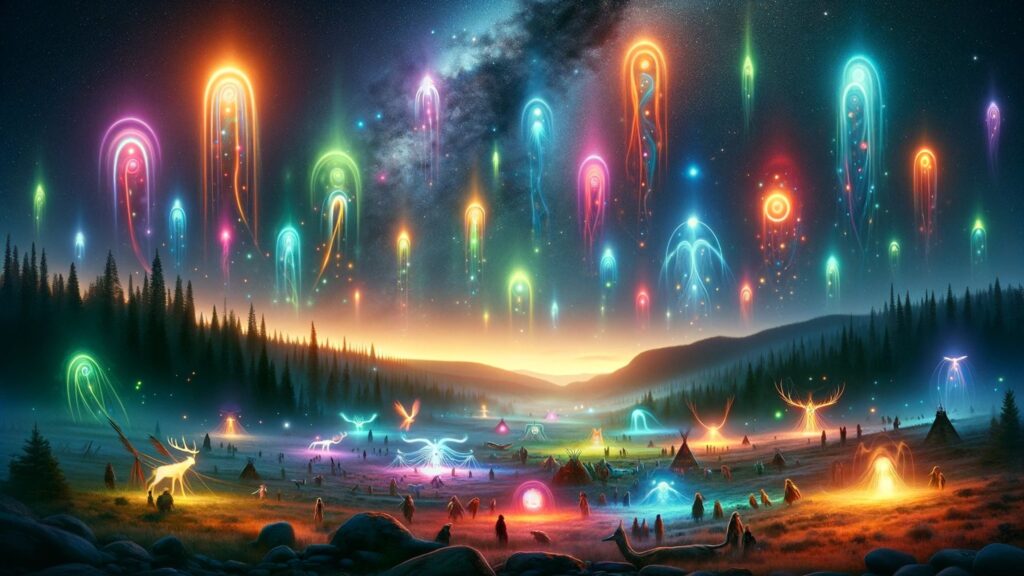
For many Native American tribes, atmospheric lights were deeply spiritual. The Pawnee of Nebraska saw the lights as a representation of warriors and hunters, while the Algonquin believed them to be ancestors’ spirits dancing in the night sky.
Spirit Lights in Native American Mythology
For many Indigenous tribes of North America, the aurora borealis is more than a natural spectacle; it’s a spiritual phenomenon. These lights are often seen as the manifestation of spirits – ancestors communicating from the afterlife, guiding and protecting their descendants. This belief highlights the deep spiritual connection these tribes have with the natural world, viewing the auroras as a bridge between the earthly and the spiritual realms.
The Pawnee: Warriors in the Sky
The Pawnee tribe of Nebraska had a unique interpretation of the Northern Lights. They envisioned them as the cosmic battle of celestial warriors, reflecting their own societal emphasis on bravery and warfare. The auroras, in this context, were seen as a symbol of valor and the eternal fight between good and evil.
Algonquin Legends: Ancestral Dances in the Heavens
The Algonquin tribes viewed the aurora borealis as their ancestors’ spirits dancing in the sky. This interpretation is deeply rooted in their respect for their forebears and the continuation of life beyond the physical world. The lights were a reminder of the enduring presence and guidance of their ancestors.
Ojibwe Beliefs: The Sky People’s Fires
Among the Ojibwe, the Northern Lights were often thought of as the “fires” of the Sky People. These celestial beings were believed to be ancestors or spiritual entities, and their fires were a way of communicating with those living on Earth. The Ojibwe’s interpretation of the auroras reflects a harmonious balance between nature, the spiritual world, and human existence.
Remember, these brilliant lights are not just natural phenomena but a canvas upon which humanity has painted its fears, hopes, and stories for millennia. Their ethereal beauty continues to inspire awe and curiosity, bridging the gap between the earthly and the divine.
FAQs About Atmospheric Lights and Their Cultural Significance
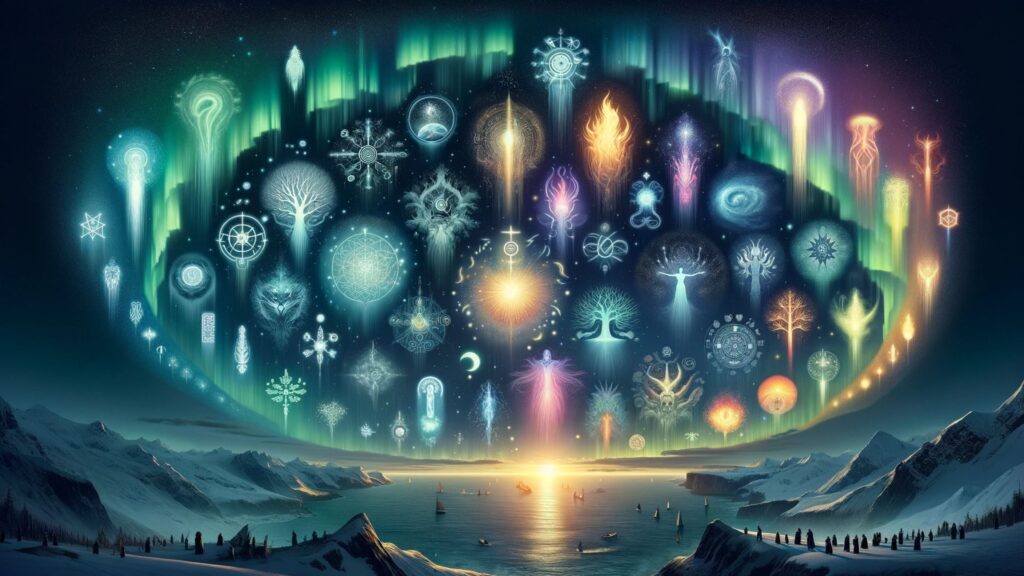
What are atmospheric lights, and how do they occur?
Atmospheric lights, such as the aurora borealis (Northern Lights) and aurora australis (Southern Lights), are natural light displays in the Earth’s sky, predominantly seen in high-latitude regions. They are caused by the interaction of solar wind – a stream of charged particles escaping the Sun – with Earth’s magnetic field and atmosphere.
How have different cultures interpreted atmospheric lights throughout history?
Cultures around the world have created diverse myths and legends to explain atmospheric lights. For instance, Norse mythology sees them as the glowing path to the realm of the gods, while many Indigenous North American tribes view them as the spirits of their ancestors.
Can atmospheric lights be seen all over the world?
Atmospheric lights are typically visible near the polar regions due to the Earth’s magnetic field. However, during strong solar storms, they can sometimes be seen at lower latitudes.
Do atmospheric lights have any scientific significance?
Yes, studying atmospheric lights helps scientists understand the Earth’s magnetosphere and its interaction with solar wind. This research is vital for understanding space weather, which can affect satellite operations, GPS systems, and even power grids on Earth.
Are there any festivals or events dedicated to atmospheric lights?
In several regions where atmospheric lights are common, like in Scandinavia and Canada, there are festivals that celebrate this phenomenon. These events often include cultural activities, traditional music, and storytelling, highlighting the lights’ cultural significance.
How do atmospheric lights influence art and literature?
Atmospheric lights have inspired numerous works of art and literature. Artists and writers often use these phenomena as motifs to convey themes of wonder, mystery, and the interplay between Earth and the cosmos.
Exploring Beyond the Aurora: A Deeper Cosmic Connection

While delving into the myths and legends surrounding atmospheric lights, it’s intriguing to consider other mysteries of the cosmos. The auroras, with their ethereal beauty, often inspire thoughts about what lies beyond our known world. This curiosity leads us to explore concepts not just rooted in our planet’s atmosphere but extending into the realms of the unknown.
For those interested in pushing the boundaries of these mysteries, the article “Interdimensional and Ultraterrestrial Beings: Unveiling the Mysteries Beyond Our World” offers a captivating exploration. It delves into the possibilities of other dimensions and entities that may exist beyond our current understanding, much like how the atmospheric lights invite us to ponder the greater mysteries of the universe.

